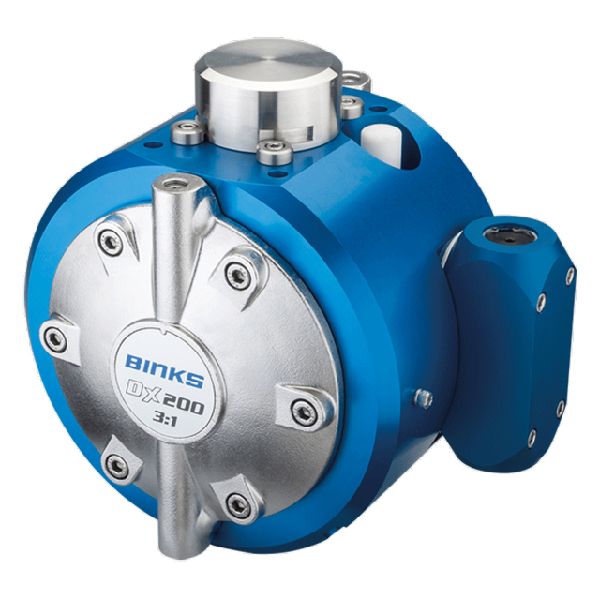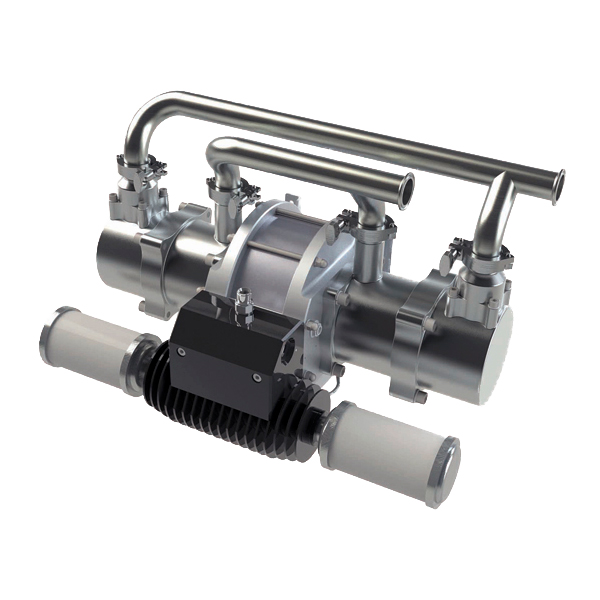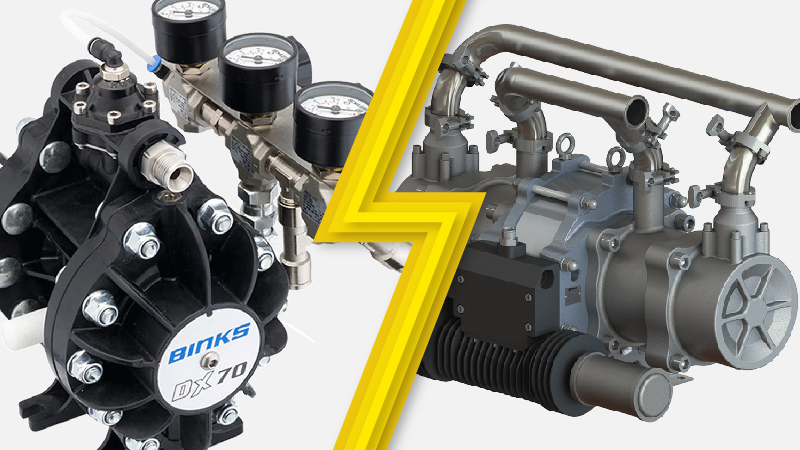Diaphragm vs. piston pumps is a debate many have had for some time. Both paint pumps are widely used in industrial finishing operations. Of course, each one has a purpose, and for that reason, it might be used ideally for some specific applications. Let’s look at them to identify the pros and cons of each one. But first, let’s understand why paint pumps are needed in industrial finishing.
Why are paint pumps needed in industrial finishing?
Any industrial plant that performs finishing jobs requires paint pumps as part of its basic equipment. There are a few reasons why paint pumps are commonly used in industrial finishing:
Flow rate control: Paint pumps allow for precise control over the flow rate of paint being applied. Operators can adjust the pump speed to achieve the desired thickness and coverage of the paint coat.
Continuous operation: Paint pumps allow paint to be supplied continuously without interruptions for manual refills or equipment changes. This allows for more efficient, uninterrupted coating of products on automated production lines.
Paint viscosity: Many industrial paints and coatings have a high viscosity that makes them difficult to apply with simple methods like brushes or rollers, or even with handheld spray guns. Paint pumps are able to handle thick, viscous paints and provide the pressure needed for proper atomization and spraying.
Large volumes: Industrial finishing often requires applying large volumes of paint. Paint pumps are capable of supplying paint at high flow rates to meet high production demands.
Precision mixing: Some paint pump systems meter and mix two-component coatings like epoxies with precise mixing ratios needed for proper curing and performance.
Operator safety: Paint pumps allow operators to apply paint from a distance, avoiding direct contact with potentially hazardous coatings. This promotes safety for industrial painters.
Consistent results: The metering and pressure control of paint pumps provides consistent, uniform coating thickness and appearance on finished products. This level of consistency is difficult to achieve with manual application methods.
We can confidently say that paint pumps are an important part of industrial finishing equipment that allow for precise, efficient, and consistent paint application at high volumes to meet production demands. Their advantages make them a staple technology in most industrial finishing processes.
Let’s now dig deeper into our topic, by defining what diaphragm paint pumps are.
What are diaphragm paint pumps?
Diaphragm pumps are a type of positive displacement paint pump that use a flexible diaphragm to create pressure and move fluid. The diaphragm is a flexible membrane that separates the fluid from the compressed air that powers the pump. As the diaphragm moves back and forth, it creates a suction that draws fluid into the pump and then forces it out through the discharge port.
Diaphragm paint pumps are commonly used for industrial finishing applications. They are well-suited for spraying a variety of materials, including latex paints, enamels, and stains. They are also compatible with both water-based and solvent-based materials.

Key features of diaphragm paint pumps
Some key features of diaphragm paint pumps are:
- They use a flexible diaphragm and check valves rather than pistons to move fluid. The reciprocating motion of the diaphragm draws fluid in and pushes it out of the pump
- Unlike piston pumps, they can handle viscous, abrasive paints and coatings without risk of wear or sticking. The diaphragm isolates the fluid chamber from the pump mechanism
- They provide smooth, pulsation-free fluid flow due to their design, which is important for precise paint metering and spray application
- They are capable of either constant pressure or constant flow operation depending on control settings
- Diaphragm construction materials like Teflon or polypropylene allow them to pump water-based or solvent-based coatings
- They are versatile pumps suitable for high pressure (up to 500 psi) or high-volume transfer applications
- Some diaphragm pumps are air-operated, meaning they run using compressed air and do not require electricity
- They handle a wide viscosity range, from thin solvents up to thick mastics or paints.
Advantages of diaphragm paint pumps
Gentle on the paint: Diaphragm paint pumps move fluid in a smooth, non-turbulent manner, which helps to prevent the paint from being sheared or aerated. This results in a better-quality finish.
Easy to clean: Diaphragm paint pumps have a simple design with only a few wet parts, which makes them easy to maintain and clean. For the same reason they are ideal for use with a variety of different materials.
Durable: Diaphragm paint pumps are built to withstand the rigors of everyday use. They are also less likely to clog than other types of paint pumps.
Versatile: Diaphragm paint pumps can be used to spray a variety of materials, including latex paints, enamels, and stains. They are also compatible with both water-based and solvent-based materials.
How does a diaphragm paint pump work?
The pump consists of a reciprocating diaphragm made of flexible material like Teflon or polypropylene sandwiched between two chambers – the fluid chamber and the air chamber.
On the fluid side, there are inlet and outlet ball check valves or flap valves. As the diaphragm moves back and forth, these valves open and close to direct fluid flow.
The power end of the pump drives the diaphragm via a connecting rod attached to a crankshaft or eccentric cam. This may be pneumatic, hydraulic or electric. Diaphragm paint pumps are typically powered by electric motors or gasoline engines. However, some models are also available that can be powered by compressed air.
Step-by-step
Here is a step-by-step explanation of how a diaphragm paint pump works:
- Compressed air is supplied to the pump through an inlet port
- The compressed air pushes on the diaphragm, causing it to move upwards
- As the diaphragm moves upwards, it creates a vacuum in the fluid chamber
- The vacuum in the fluid chamber draws fluid into the pump through the suction port
- Once the fluid chamber is full of fluid, the compressed air is directed to the opposite side of the diaphragm
- The compressed air pushes on the diaphragm, causing it to move downwards
- As the diaphragm moves downwards, it forces the fluid out of the pump through the discharge port
- This sequence repeats rapidly, creating smooth pulsation-free paint flow. The pump self-primes as long as the suction stroke creates adequate vacuum to lift fluid up to the chambers
The flow rate is controlled by adjusting the cycle speed and stroke length. The diaphragm size also affects flow rate and pressure capabilities. The reciprocating action of the diaphragm, combined with the check valves, eliminates voids and provides consistent output flow.
Best applications for diaphragm paint pumps
Here are some of the top applications where diaphragm paint pumps excel in paint and coating operations:
Transferring paint from storage tanks to coating machines: Diaphragm paint pumps handle high viscosity coatings well and can pump at high flow rates for quickly filling reservoirs.
Metering paint and tinting colorants: The smooth flow of diaphragm pumps allows precise injection of paint in metered quantities or accurate tinting dispensing.
Supplying paint to spray guns: Diaphragm pumps can supply paint under pressure for airless/air-assisted airless spray guns. Their pulsing-free flow prevents spray jitter.
Feeding coating machines like rolls, curtains, and flow coaters: Diaphragm paint pumps excel at consistently supplying viscous coatings to coating heads.
Circulating and filtering paint: Diaphragm paint pumps recirculate paint from reservoirs through filters to remove gels and impurities.
Transferring waste paint/solvents: Durable chemical resistance allows diaphragm paint pumps to transfer waste coatings and cleaning solvents.
Fluid handling in electrodeposition painting systems: Diaphragm pumps resist corrosion from paint chemicals in e-coat processes.
Supplying coatings in dip tanks: Smooth flow allows consistent viscosity and coating of parts dipped into tanks.
Paint mixing and blending operations: Diaphragm pumps blend high viscosity paints better than centrifugal pumps.
Paint circulation in tanks to prevent settling: Diaphragm pumps can recirculate solids-laden paints to maintain consistency.
So, in summary, diaphragm pumps combine durability, smooth fluid delivery, and versatility to make them ideal for metering, transferring or spraying paint in industrial finishing lines. Their design makes them well-suited for demanding coating applications. They are ideal for accurately moving or supplying paint in many industrial coating processes while handling difficult paint properties with reliability.
Now it is time to look at the piston paint pumps. Let’s start by defining them.
What are piston paint pumps?
Piston paint pumps are another type of positive displacement pump that uses a piston to create pressure and move fluid. The piston is a cylindrical plunger that fits tightly inside a cylinder. As the piston moves back and forth, it creates a suction that draws fluid into the pump and then forces it out through the discharge port.
Piston paint pumps are well-suited for spraying a variety of materials, including latex paints, enamels, and stains. They are also compatible with both water-based and solvent-based materials.
Piston paint pumps are typically powered by electric motors or gasoline engines. However, some models are also available that can be powered by compressed air.

Key features of piston paint pumps
Some key features of piston paint pumps are:
- They use a reciprocating piston instead of a diaphragm to displace fluid. The piston moves back and forth in a bore or cylinder
- Inlet and outlet valves alternate to allow fluid to enter and leave the cylinder
- Piston pumps provide high pressure capabilities up to 1500 psi or more
- They are capable of high pumping speeds for high flow rates
- Their tight clearances provide consistent, pulse-free flow
- Piston pumps handle well medium to high viscosity fluids
- They require scheduled maintenance like repacking seals more frequently than diaphragm pumps
- Pistons can wear over time from contact with abrasive coatings
- They need filtration when handling abrasive paints to prevent wear
- Leakage around pistons is a potential issue requiring adjustment
- Piston pumps work well for high pressure spray painting or transferring paint long distances where pressure must be maintained
- They are used for precise paint metering and dispensing in some applications
- Smaller pistons generate higher pressures while larger ones provide higher flow rate
- Packings and seals prevent internal leakage for consistent flow
- The fluid only contacts the piston and valves, keeping contaminants out of the crankcase
- Flow rate can be increased by running the pump at higher speeds
- The pressure is directly related to the piston area and force applied
Advantages of piston paint pumps
High pressure: Piston paint pumps can generate very high pressures, which makes them ideal for spraying thick, viscous materials.
Precise control: Piston paint pumps offer precise control over the spray pressure and flow rate, which makes it easy to achieve a professional-looking finish.
Durable: Piston paint pumps are built to withstand the rigors of everyday use. You can expect to use a piston pump for many years.
Versatile: Piston paint pumps can be used to spray a variety of materials, including latex paints, enamels, and stains. They are also compatible with both water-based and solvent-based materials.
How does a piston paint pump work?
The pump consists of a piston moving back and forth inside a cylindrical bore. The piston is connected to a crankshaft and motor. Inlet and outlet valves are located at each end of the cylinder bore. As the piston retracts, it creates suction which opens the inlet valve, drawing paint into the cylinder. The outlet valve remains closed during the intake stroke. When the piston changes direction and advances, it pressurizes the paint inside the cylinder. This closes the inlet valve and forces the outlet valve open, discharging the paint.
The continuous reciprocating action of the piston sucks in fluid and discharges it with each cycle. Piston pumps only displace fluid when the piston moves in the forward direction. The retreat stroke does not actively pump. Tight clearances between the piston and cylinder allow high pressures to build up and be maintained.
Step-by-step
Here is a step-by-step explanation of how a piston paint pump works:
- The piston is at the bottom of the cylinder
- The inlet valve opens, and fluid is drawn into the cylinder
- The inlet valve closes, and the piston moves upwards
- As the piston moves upwards, it compresses the fluid in the cylinder
- When the fluid is sufficiently compressed, the outlet valve opens, and the fluid is forced out of the pump
- The outlet valve closes, and the piston moves downwards
- The cycle repeats itself over and over again, creating a continuous flow of fluid.
In a few words, the synchronized action of the valves and pistons during intake and discharge strokes generates smooth paint flow in piston pumps. Precision clearances allow high pressure capability.
Best applications for piston paint pumps
Here are some of the top applications where piston paint pumps excel in paint and coating operations:
High pressure spray painting: Piston pumps can achieve the pressures needed for airless and air-assisted airless spray painting. They supply a pulse-free flow of paint to the spray gun.
Long distance paint transfer: Maintaining pressure for transferring paint long distances from storage to applicators is a strength of piston pumps.
Precision paint metering/dispensing: The high pressures and smooth flow enable piston pumps to meter and apply precise coating amounts.
Supplying coating machines: Piston pumps maintain constant pressure feeding high viscosity coatings to machines like roll/curtain coaters.
Automotive painting: The high pressures and flow rates aid piston pumps in painting cars and large surfaces, like buses and airplanes.
Printing inks: Precise flow and pulse-free metering make piston pumps suitable for supplying printing inks.
Ceramic glazes: Smooth flow avoids defects, and pressure atomizes glazes evenly.
Chemical processing: Handling corrosive or volatile paints or coatings safely is possible with piston pumps.
Abrasive fluid pumping: Despite wear issues, piston pumps can handle abrasive fluids well in short term applications.
Fluid transfer to elevated spray lines: Piston pumps can transfer paint vertically 30+ feet in some industrial paint lines.
In many high pressure, precision metering, or challenging paint applications, piston pumps are advantageous. Their strengths complement those of diaphragm pumps.
Diaphragm vs piston pumps: How to choose
The best type of paint pump for you will depend on your specific needs and requirements. Basically, if you are looking for a pump that is gentle on the paint and easy to clean, then a diaphragm pump is a good choice. If you need a pump that can generate high pressure and offer precise control, then a piston pump is a better choice.
Some additional factors to consider when debating between diaphragm vs. piston pump can be price, ease of use, portability, and maintenance. Make sure you know all this information before making up your mind. Now, this consideration would only take place if your current situation would allow the use of either a diaphragm or piston pump. In many cases, the ideal is one or the other.
If you are still unsure which type of paint pump is right for you, we can help you to decide. Feel free to contact us anytime.
Now, diaphragm vs. piston pumps is not the possibility. There are more types of paint pumps under the sun. Let’s take a look at them.
Other types of paint pumps
Besides diaphragm and piston, there are other types of paint pumps used in industrial finishing, like:
- Rotary Vane Pumps: Reliable, simple, low pulse pumping for medium duties
- Peristaltic Pumps: Precise flow control, low shear for delicate or metallic paints
- Centrifugal Pumps: Economical, high flow rates, often used to feed other pump types
- Gear Pumps: Reliable, handle high viscosity paints, pulses may require pulsation dampeners
- Progressive Cavity Pumps: Self-priming, consistent flow, useful where high back pressure encountered
- Screw Pumps: Capable of very high flow rates, low shear, less pressure than piston pumps
- Lobe Pumps: Low shear, low pulsation, careful design needed for abrasive paints
- Pneumatic Pump Cylinders: Simple, portable paint supply using compressed air to displace fluid
The optimum paint pump depends on factors like paint properties, production needs, and application. Many systems use a combination of pump types for tasks like transfer, circulation, metering and spray supply.
Diaphragm vs piston pumps: Final thoughts
When deciding between diaphragm vs. piston pump, the pros and cons of each one should be a heavy factor to consider. Usually, the best idea is to get an expert’s advice. We can help you with that, because our experts have decades of experience installing both diaphragm and piston paint pumps in different industrial finishing plants. Contact us whenever possible to get started in your project.





